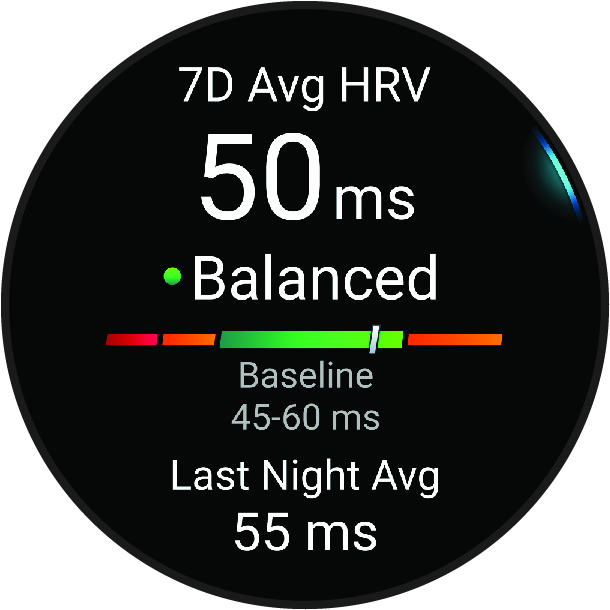Performance Measurements
These performance measurements are estimates that can help you track and understand your training activities and race performances. The measurements require a few activities using wrist-based heart rate or a compatible chest heart rate monitor.
These estimates are provided and supported by Firstbeat Analytics. For more information, go to www.Garmin.com/performance-data/running/.
NOTE: The estimates may seem inaccurate at first. The watch requires you to complete a few activities to learn about your performance.
VO2 max.: VO2 max. is the maximum volume of oxygen (in milliliters) you can consume per minute per kilogram of body weight at your maximum performance ().
Predicted race times: The watch uses the VO2 max. estimate and your training history to provide a target race time based on your current state of fitness ().
HRV status: The watch analyzes your wrist heart rate readings while you are sleeping to determine your heart rate variability (HRV) status based on your personal, long-term HRV averages ().
VO2 max. is the maximum volume of oxygen (in milliliters) you can consume per minute per kilogram of body weight at your maximum performance. In simple terms, VO2 max. is an indication of athletic performance and should increase as your level of fitness improves. The Forerunner device requires wrist-based heart rate or a compatible chest heart rate monitor to display your VO2 max. estimate.
On the device, your VO2 max. estimate appears as a number, description, and position on the color gauge. On your Garmin Connect account, you can view additional details about your VO2 max. estimate, such as where it ranks for your age and sex.

|
|
Superior |
|
|
Excellent |
|
|
Good |
|
|
Fair |
|
|
Poor |
VO2 max. data is provided by Firstbeat Analytics. VO2 max. analysis is provided with permission from The Cooper Institute®. For more information, see the appendix (), and go to www.CooperInstitute.org.
Getting Your VO2 Max. Estimate for Running
This feature requires wrist-based heart rate or a compatible chest heart rate monitor. If you are using a chest heart rate monitor, you must put it on and pair it with your watch ().
For the most accurate estimate, complete the user profile setup (), and set your maximum heart rate (). The estimate may seem inaccurate at first. The watch requires a few runs to learn about your running performance. You can disable VO2 max. recording for ultra run and trail run activities if you do not want those run types to affect your VO2 max. estimate ().
- Start a running activity.
- Run for at least 10 minutes outdoors.
- After your run, select Save.
- Press UP or DOWN to scroll through the performance measurements.
Turning Off VO2 Max. Recording
You can disable VO2 max. recording for ultra run and trail run activities if you do not want these run types to affect your VO2 max. estimate ().
- Hold UP.
- Select Activities & Apps.
- Select Trail Run or Ultra Run.
- Select the activity settings.
- Select Record VO2 Max. > Off.
Viewing Your Predicted Race Times
For the most accurate estimate, complete the user profile setup (), and set your maximum heart rate ().
Your watch uses the VO2 max. estimate and your training history to provide a target race time (). The watch analyzes several weeks of your training data to refine the race time estimates.
- From the watch face, press UP or DOWN to view the performance glance.
- Press START to view glance details.
- Press UP or DOWN to view a predicted race time.

- Press START to view predictions for other distances.
NOTE: The predictions may seem inaccurate at first. The watch requires a few runs to learn about your running performance.
Your watch analyzes your wrist heart rate readings while you are sleeping to determine your heart rate variability (HRV). Training, physical activity, sleep, nutrition, and healthy habits all impact your heart rate variability. HRV values can vary widely based on gender, age, and fitness level. A balanced HRV status may indicate positive signs of health such as good training and recovery balance, greater cardiovascular fitness, and resilience to stress. An unbalanced or poor status may be a sign of fatigue, greater recovery needs, or increased stress. For best results, you should wear the watch while sleeping. The watch requires three weeks of consistent sleep data to display your heart rate variability status.

|
Status |
Description |
|
Balanced |
Your seven-day average HRV is within your baseline range. |
|
Unbalanced |
Your seven-day average HRV is above or below your baseline range. |
|
Low |
Your seven-day average HRV is well below your baseline range. |
|
Poor No status |
Your HRV values are averaging well below the normal range for your age. No status means that there is insufficient data to generate a seven-day average. |
You can sync your watch with your Garmin Connect account to view your current heart rate variability status, trends, and educational feedback.
Training Effect measures the impact of an activity on your aerobic and anaerobic fitness. Training Effect accumulates during the activity. As the activity progresses, the Training Effect value increases. Training Effect is determined by your user profile information and training history, and heart rate, duration, and intensity of your activity. There are seven different Training Effect labels to describe the primary benefit of your activity. Each label is color coded and corresponds to your training load focus. Each feedback phrase, for example, "Highly Impacting VO2 Max." has a corresponding description in your Garmin Connect activity details.
Aerobic Training Effect uses your heart rate to measure how the accumulated intensity of an exercise affects your aerobic fitness and indicates if the workout had a maintaining or improving effect on your fitness level. Your excess post-exercise oxygen consumption (EPOC) accumulated during exercise is mapped to a range of values that account for your fitness level and training habits. Steady workouts at moderate effort or workouts involving longer intervals (>180 seconds) have a positive impact on your aerobic metabolism and result in an improved aerobic Training Effect.
Anaerobic Training Effect uses heart rate and speed (or power) to determine how a workout affects your ability to perform at very high intensity. You receive a value based on the anaerobic contribution to EPOC and the type of activity. Repeated high-intensity intervals of 10 to 120 seconds have a highly beneficial impact on your anaerobic capability and result in an improved anaerobic Training Effect.
You can add Aerobic Training Effect and Anaerobic Training Effect as data fields to one of your training screens to monitor your numbers throughout the activity.
|
Training Effect |
Aerobic Benefit |
|
From 0.0 to 0.9 |
No benefit. |
|
From 1.0 to 1.9 |
Minor benefit. |
|
From 2.0 to 2.9 |
Maintains your aerobic fitness. |
|
From 3.0 to 3.9 |
Impacts your aerobic fitness. |
|
From 4.0 to 4.9 |
Highly impacts your aerobic fitness. |
|
5.0 |
Overreaching and potentially harmful without enough recovery time. |
Training Effect technology is provided and supported by Firstbeat Analytics. For more information, go to www.firstbeat.com.
 Purple
Purple Blue
Blue Green
Green Orange
Orange Red
Red